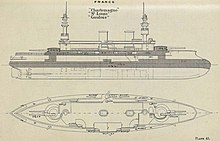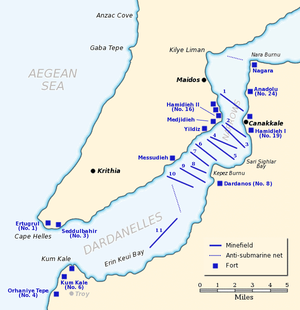Charlemagne-class battleship
They had oddly eventful peacetime careers as they were involved in four accidental collisions among them, one of which sank a French submarine with all hands.
All three ships were ordered to the Dardanelles in November 1914 to guard against a sortie into the Mediterranean by the German battlecruiser SMS Goeben.
After repairs she returned to the Dardanelles and rejoined her sisters, providing fire support during the Gallipoli Campaign until the Allies evacuated their troops.
Saint Louis and Charlemagne were transferred to the squadron assigned to prevent any interference by the Greeks with Allied operations on the Salonica front in 1916 and Gaulois was en route to join them when she was sunk by a German submarine later that year.
[1][5] They carried a maximum of 1,050 tonnes (1,030 long tons) of coal which allowed them to steam for 4,200 miles (3,600 nmi) at a speed of 10 knots (19 km/h; 12 mph).
[1] The Charlemagnes carried their main armament of four 40-calibre Canon de 305 mm (12 in) Modèle 1893 guns in two twin-gun turrets, one each fore and aft.
[7] The guns fired 349.4-kilogram (770 lb) armour-piercing projectiles at a muzzle velocity of 815 m/s (2,670 ft/s)[6] at a theoretical rate of one round every 1.3 minutes.
[5] Their anti-torpedo boat defences consisted of twenty 40-calibre Canon de 47 mm (1.9 in) Modèle 1885 Hotchkiss guns, fitted in platforms on both masts, on the superstructure, and in casemates in the hull.
Saint Louis became the flagship of the squadron almost as soon as she reached Toulon and all three participated in a number of port visits and naval reviews.
[20] Together with the battleships Iéna and Bouvet, Gaulois aided survivors of the April 1906 eruption of Mount Vesuvius in Naples.
[21] All three ships were transferred to the Northern Squadron in 1909–1910 and Saint Louis was accidentally rammed by the destroyer Poignard during manoeuvers off Hyères in 1911.
[3][23] Together with the older French pre-dreadnoughts, the trio escorted Allied troop convoys through the Mediterranean for the first several months of the war.
All three ships were ordered to Tenedos Island, not far from the Gallipoli Peninsula of Turkey, in November to guard against a sortie by the German battlecruiser Goeben.
Gaulois became the temporary flagship of Rear Admiral (contre-amiral) Émile Guépratte upon her arrival until the return of the battleship Suffren in January 1915.
[24] Saint Louis became the flagship of the newly formed Syrian Squadron (Escadre de Syrie) on 9 February.
The squadron was intended to attack Turkish positions and lines of communication in Syria, Lebanon, Palestine and the Sinai Peninsula.
Saint Louis participated in the bombardment of Gaza and El Arish in April before she was transferred back to the Dardanelles in May.
Five days later, the French squadron attempted to suppress the Turkish guns while British battleships bombarded the fortifications.
She made Toulon without further incident where the ship was refitted and extensively modified to improve her stability, returning to the Dardanelles in July.
Saint Louis arrived that same month and both ships provided fire support for French troops ashore.
[3] Charlemagne was transferred to Salonica in October 1915 where she joined the French squadron assigned to prevent any interference by the Greeks with Allied operations in Greece.
[3][27] Gaulois remained at the Dardanelles until August, covering the evacuation of Allied troops from Gallipoli at the end of 1915, when she started a refit at Brest.

